There’s something magical when a flavor matches a feeling.
Tourtière possesses that magic in full abundance. A single bite taken into this spiced meat pie evokes the cheerful, warming spirit of the holidays.
It’s no wonder, then, that it’s a key fixture to any true Quebecois celebration of Christmas… and now at our own too.

Tourtière, Liber de Coquina, and Tourte Pans
Tourtière as we know it today is through and through a Quebecoise treat, but that’s only a half of the greater tale.
To really get a fuller sense of where this sensational recipe might have come from, we’ll be taking a trip back a few centuries to the time of the Liber de Coquina.
Liber de Coquina
To be fair, it would be incorrect to say that the Liber de Coquina was the genesis of the pie. That honor is reserved either for the Mesopotamians or the Egyptians thousands of years before. You won’t find either the original recipe for spicing meats, which has been in practice by civilizations worldwide since ancient times.
As one of the earliest and best preserved cookbooks from the medieval European period, the 13th century Liber de Coquina has played a pivotal role in shaping mainland European cuisines and those of the “colonial offshoots.” It’s in this medieval cookbook that we find the earliest ancestor to our modern-day tourtière: the torta parmigiana.
While more reminiscent of another Quebecois meat pie, cipaille, the torta parmigiana was one of the book’s most complex creations where spiced meats were combined with thin layers of dough a multi-layered pie. As the name suggests, the recipe came out of the Italian town of Parma, but the concept soon spread past Italy, into French cuisine and beyond. By the 1700s, there were literally hundreds of torta recipes circulating around Europe and the New World.
By the way, if you love the combination of pie plus meat, you might want to check out our Serbian cheese pie made with phyllo dough and goat cheese (gibanica), or a sweet and savory chicken thigh pie also made with phyllo dough (bastilla). Is it a pie, is it a meat dish? You can decide!
French Canadian Cuisine and the Tourte
By the early 17th century, the French launched a more concerted effort to settle and colonize parts of the New World. Led by Samuel de Champlain, French Canada – and its capital, Quebec City – became a prized possession of greater New France.
Until the 1840 publication of La Cuisinière Canadienne, a seminal cookbook that defined the French Canadian national cuisine, the settlers would try to adapt French cooking to their new local environment. What developed was a local cuisine that combined traditional French methods with starkly different ingredients from the mainland. Ingredients like maple sugar, game meats and local legumes and vegetables easily made their way into the local diet.
Yet despite the increasing differences, a lot of recipes remained similar, one of them being the tourte. Much like the torta parmigiana, the French had developed their own version of a pie crust stuffed with a savory meaty filling. The recipe had become so ubiquitous in France that even the shallow pie dish used to cook the pie was itself named the tourte.
The recipe remained highly popular in the burgeoning cuisine of New Canada, and by the time of La Cuisinière Canadienne, the recipe had evolved into a truly Quebecoise tourtière.
About the Recipe
What’s really interesting about tourtière is that there’s little to no consensus on what the meat the pie is actually stuffed with. Some recipes use just pork, others a mixture of pork and beef, and you can even find recipes including even game meats or salmon!
Still, amid all the diversity, there’s some reasonably general consensus on what makes a tourtière: the spices, the filling and the crust.
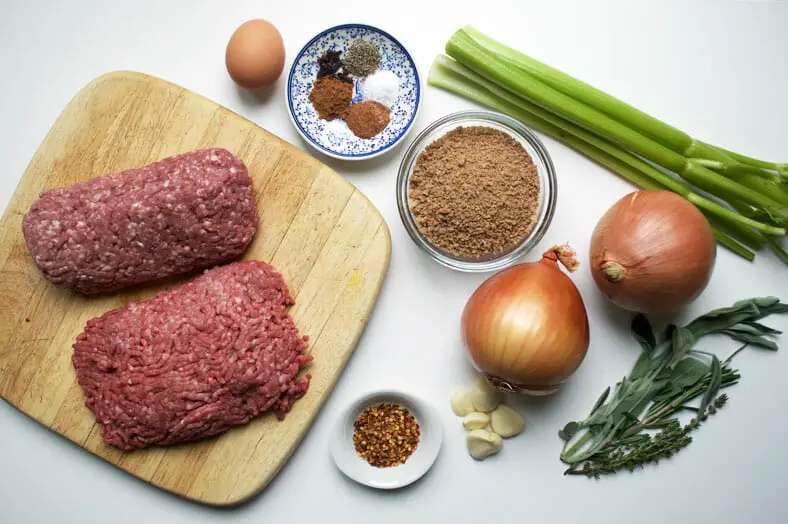
The Meat Filling and Spices
For the tourtière, the “meat” in the meat pie can really be anything, although many traditionalists will suggest that pork is most common. Whatever meat you do choose to use, though, you’ll want to make sure there is a reasonable amount of fat content to carry the flavor through both the stovetop cooking and the baking processes. If you do choose to add a gamey or leaner meat into your tourtière, just be sure to pair it with a fattier meat like pork is.
One of the keys to preparing this delicious meat pie in an optimal fashion is to pre-cook the filling but to make it cold soon thereafter. It will heat back up when it’s steaming in the pie, but making it cold helps to prevent it from overcooking.
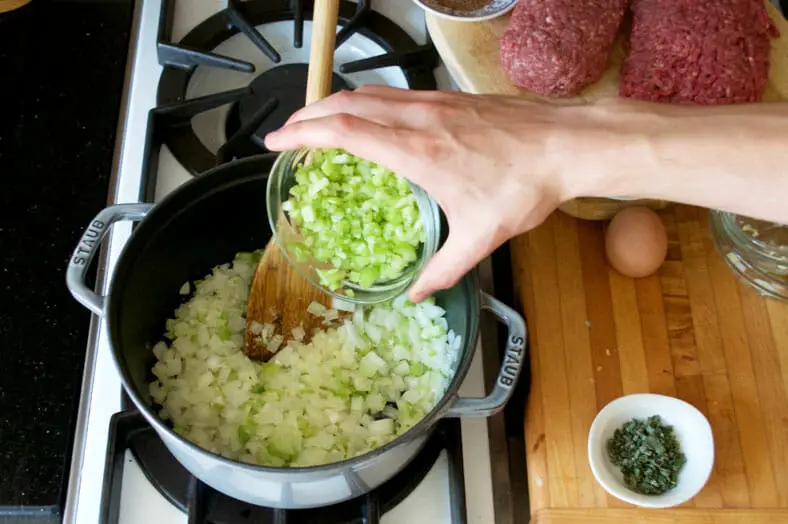
To prepare your filling, start by sautéing some aromatic ingredients like onions, celery and garlic together. When these ingredients have softened, you’ll add in your ground meat and break it into smaller pieces. Technically, the original versions of tourtière were made with small chunks of meat, but the recipe has been adapted enough that it’s more custom to include ground meat instead. It’s key not to overcook your ground filling, especially not before adding in your stock and thickener. As you see the meat to slightly start to brown, that’s the perfect time to pour in some stock (or even water works) and your spices.
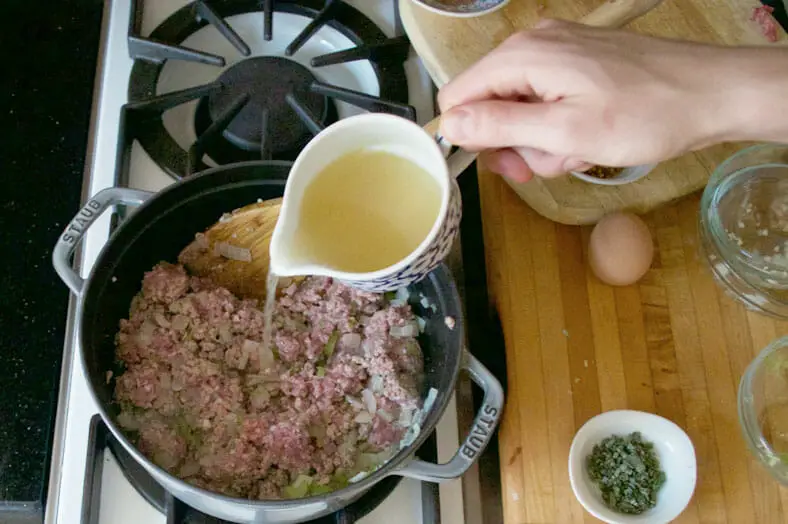

The spices are the only part of tourtière that everyone seems to agree upon. In the most traditional sense of the recipe, there are four that absolutely must be included: cinnamon, cloves, allspice and nutmeg. Additional aromatics like thyme, sage, rosemary or savory are optional (though recommended), but those four spices are absolutely crucial to the flavor of the dish.
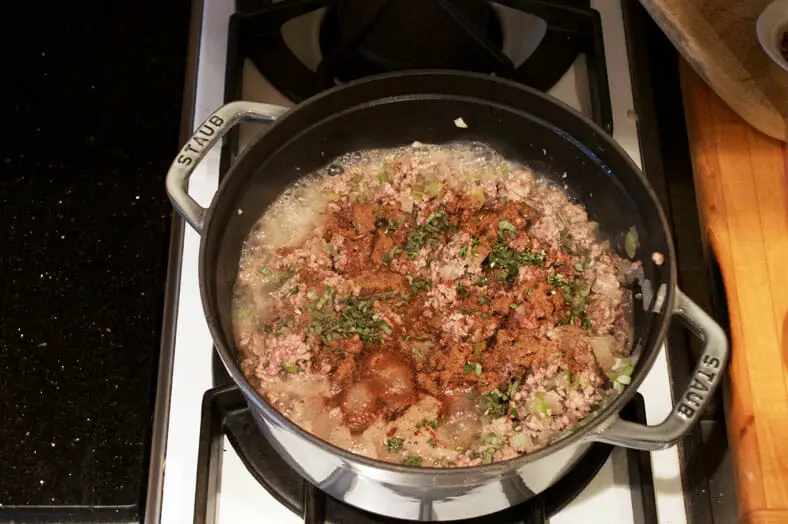
It’s easiest to used the spices in their ground powdery forms, which you can add in with the stock and mix into your ground meat pretty effectively. Once the meat, stock and spices has been mixed well together, you’ll add the final piece to the filling puzzle: the thickener.

The thickener is another area where people differ in their recipes. Some will advocate using potatoes to mop up the cooked juices, whereas others will suggest oats. Other camps (like ours) will use breadcrumbs, but the desired result is the same. So long as you get a thickened, stewy mixture, you’re all good to go.
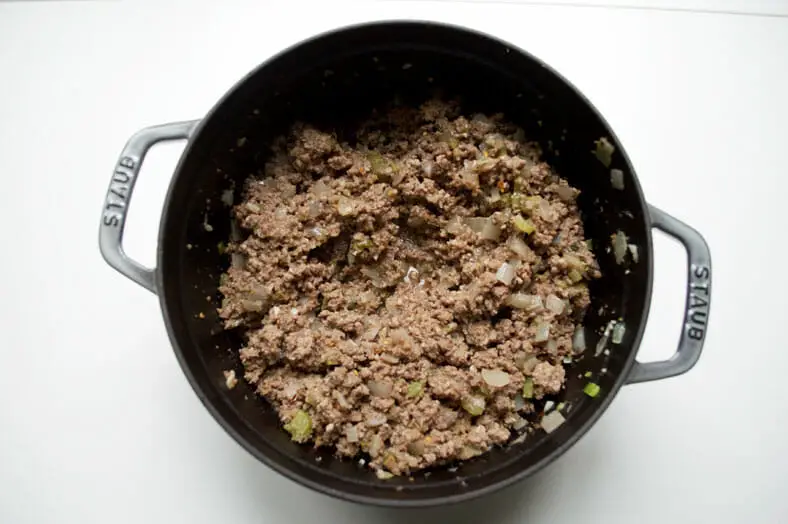
The final step to preparing your filling is to take it off your stovetop heat, place it in the fridge for at least an hour, and let it cool.
The Pie Crust and Assembly
Because the tourtière filling needs time to cool down, this is actually a perfect opportunity to make a pie crust from scratch. It’s not at all necessary – and store bought can just as easily do the trick – but if you’re feeling ambitious like we were, then this is the perfect time to shine. The discussion of how to make the perfect pie crust is one we’ll spare for another post, though, since it’s really a science of its own.
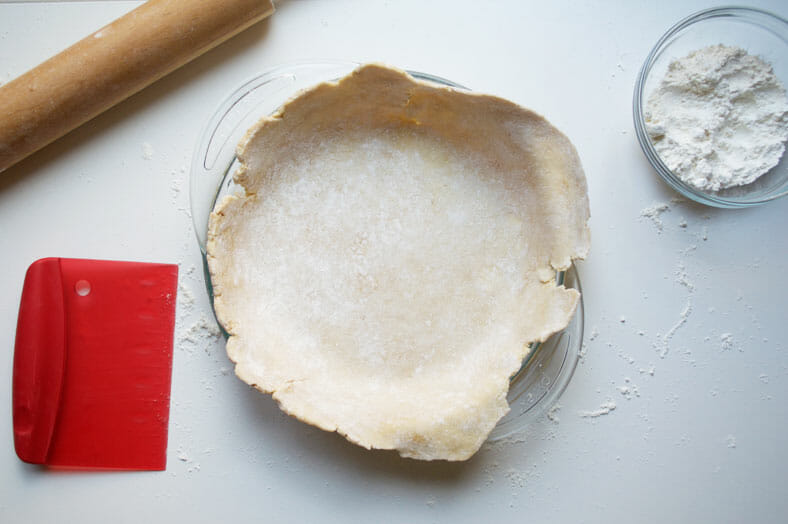
Putting the tourtiere together once filling and crust are made is a really simple process. Line your pie dish with one half of your pie crust, then put as much of the meat filling into the middle as you can. As the meat cooks further, the proteins will contract and the filling will shrink, so don’t be bashful in stuffing in as much as you can.
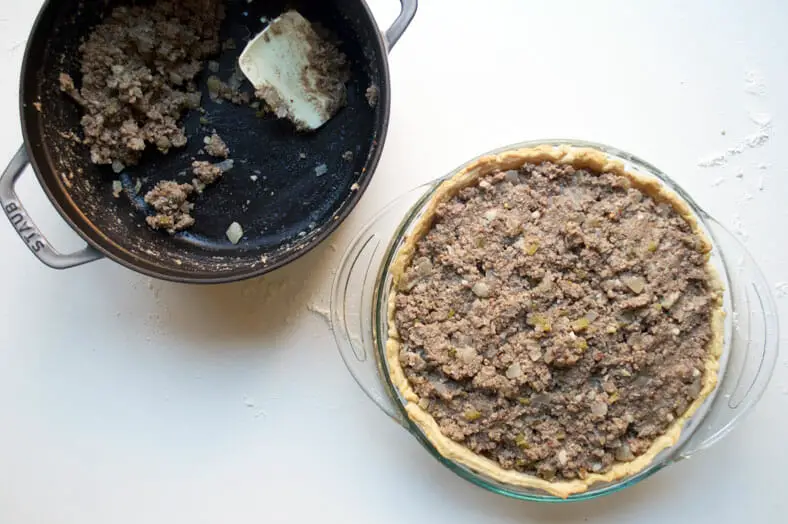
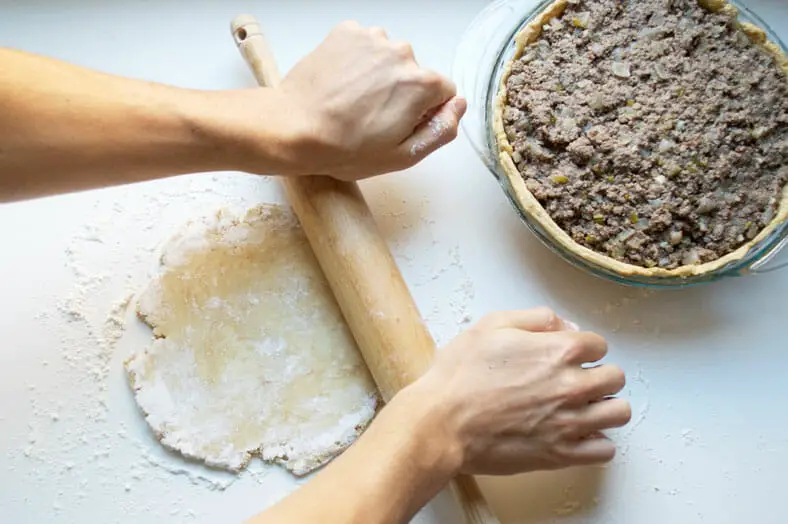
From there, cover your tourtière with the other sheet of pie crust and pinch it tightly closed. Be sure to cut a few slits to allow the steam to escape from the pie, then just pop it into the oven and let it bake. Towards the end, if you’re looking for a beautiful, crispy golden outside, brush the top with some egg, butter or milk wash in the final 10 minutes of baking.
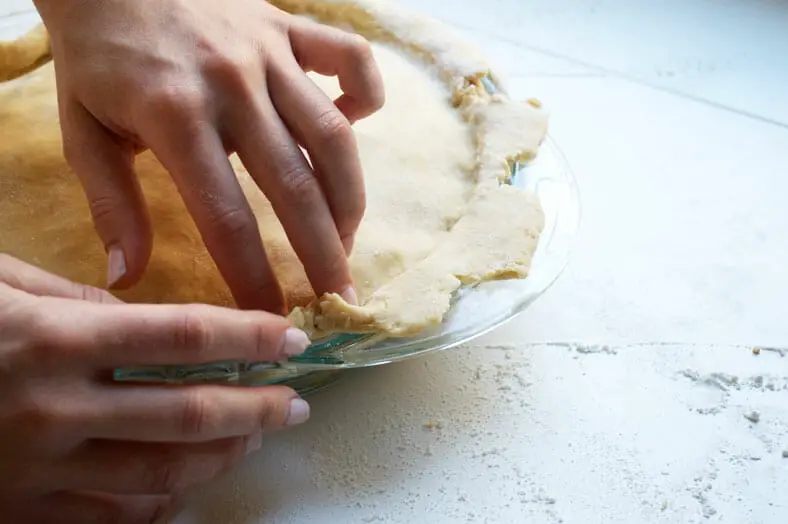
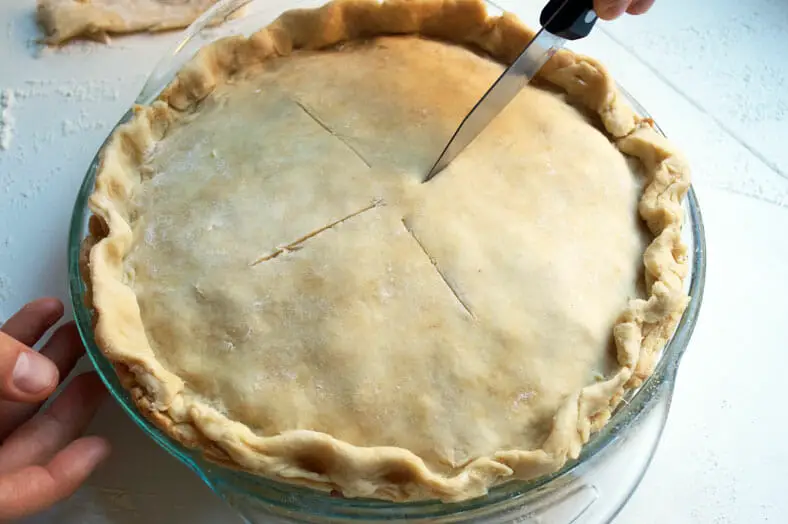
After that, just take the tourtière out, let it cool, and enjoy!
Our Take on the Recipe
Given the diversity in the tourtière recipes out there, it seemed only fair to use one from a site entirely dedicated to the meat pie as our reference recipe. The recipe was by no means perfect, however, and there were quite a few changes we felt needed to be made.
For starters, we made our own crust from scratch. We had the time, and we find that it does more justice to the recipe than if we were to list pre-made pie crusts as an ingredient. That was entirely our prerogative, though, and you should feel absolutely free to use whatever you’d like in your own cooking.
In terms of ingredient substitutions, we swapped out the potatoes for breadcrumbs partially because we didn’t like what the potato did to the taste of the dish. The potato did a great job of thickening the filling, but it neutralized a lot of the spiced flavors that we wanted to highlight. Breadcrumbs, for us, did just the trick instead. We also added a few more aromatic ingredients like celery, sage and thyme to our version of the meat pie.
One part of this recipe that we did really like was the inclusion of crushed red pepper flakes. We hadn’t seen it very much in other recipes, but it left a subdued, lasting bite to the tourtière that we really enjoyed. In the end, we did scale the amount used down, but we added more garlic back in as a balance.
In all, tourtière was one recipe that we’re excited to make over and over, especially as the holiday season comes upon us. It’s as festive in taste as it looks, and it makes a fragrant, delicious addition to any holiday meal table.
Enjoy!
What meat would you use in your tourtière? Comment below!



Wow this looks amazing! I tried a Tourtiere pie once when I was younger and have been wanting to make one ever since but it seems so daunting. Yours looks pretty straightforward and super tasty!!
That’s awesome to hear, Taylor! It really is super straightforward to make, and it can actually be really fun to do as a group activity. If you give it a try, let us know! 🙂
I love how you always provide the history about the food and so I always learn something new! This pie has all my favorite spices so I know it’s totally delicious! Holiday-perfect indeed!!!
Thanks Manila Spoon, and so glad that you’re able to learn something new from this 🙂 If you make the pie for the holidays, let us know about it!
I love meat pies – from all over the world. The ingredient that surprised me the most in this one was the heavy dose of crushed red pepper flakes. But they make sense and must balance out the sweeter spices nicely. A perfect dish for a cold winter night.
The red pepper flakes weren’t in most recipes we found, and we’re chalking it up most likely to some “creative liberties” at the hands of a few cooks, but they do indeed work out well. We tried recipes both with and without the flakes, and in the end the recipe with the pepper flakes just tasted, like you said, much more balanced and agreeable